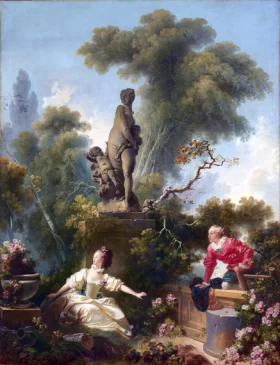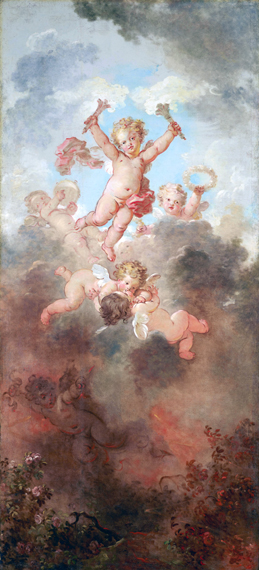5% Off Sitewide | Use code KMUS5 on checkout
- Choose your Country
5% Off Sitewide | Use code KMUS5 on checkout
Rococo
The Rococo art movement emerged in the early 18th century as a lighthearted and ornamental response to the grandeur and formality of the preceding Baroque period. Originating in France, Rococo art quickly spread throughout Europe, captivating audiences with its playful, elegant, and decorative aesthetic. The Rococo style encompassed various artistic disciplines, including painting, sculpture, architecture, interior design, and even fashion. It celebrated beauty, sensuality, and the pleasures of life, reflecting the cultural and social changes of the time.
Rococo art is characterized by its emphasis on delicate, curvilinear forms, intricate ornamentation, pastel color palettes, and themes of love, nature, and leisure. The movement rejected the grandiosity and solemnity of the Baroque in favor of a more intimate and graceful approach. Artists sought to create visually pleasing and enchanting compositions that evoked a sense of charm, fantasy, and escapism.
One of the notable features of Rococo painting is its focus on aristocratic subjects, such as elegant courtiers, leisurely gatherings, and scenes of love and flirtation. Artists like Jean-Antoine Watteau and François Boucher captured the romanticized world of the upper class, infusing their paintings with a sense of playfulness and refined sensibility. These works often depicted idyllic landscapes, lush gardens, and opulent interiors as backdrops for graceful figures engaged in leisurely activities.
Sculpture in the Rococo style was characterized by its intricate detailing, graceful poses, and soft, flowing drapery. Sculptors such as Jean-Baptiste Pigalle and Étienne-Maurice Falconet crafted works that showcased a sense of movement and a celebration of the human form. Sculptures often depicted mythological figures, allegorical themes, or idealized portraits of aristocratic patrons, reflecting the taste and interests of the time.
Rococo architecture played a significant role in shaping the visual landscape of the period. Elaborate palaces, country estates, and opulent interiors were designed with meticulous attention to detail. Architects like François de Cuvilliés and Ange-Jacques Gabriel created spaces that exuded extravagance, incorporating ornate moldings, gilded accents, and playful motifs. The aim was to create luxurious environments that delighted the senses and served as symbols of wealth and social status.
The Rococo style extended beyond the realm of art and permeated everyday life. It influenced fashion, interior design, and even the decorative arts. Furniture, ceramics, and textiles embraced the Rococo aesthetic, featuring delicate craftsmanship, intricate patterns, and motifs inspired by nature, such as flowers, shells, and feathers.
The Rococo movement flourished during the 18th century, particularly in France and Austria, where it was favored by the aristocracy and the court. However, by the mid-18th century, the style began to face criticism for its perceived frivolity and excess. The emergence of the Neoclassical movement, with its emphasis on reason, morality, and simplicity, marked a shift away from the ornamental and decorative qualities of Rococo art.
Despite its eventual decline in popularity, the Rococo movement left a lasting impact on the art world. Its emphasis on pleasure, beauty, and elegance challenged the prevailing notions of artistic expression and influenced subsequent artistic movements. The Rococo aesthetic continued to be revisited and reinterpreted in later periods, resurfacing in the decorative arts, fashion, and even contemporary art.
In conclusion, the Rococo art movement of the 18th century represents a delightful departure from the grandeur and solemnity of the Baroque era. Its emphasis on charm, grace, and decorative allure created a visual language that celebrated the pleasures of life. Rococo art continues to enchant audiences with its delicate beauty, intricate details, and whimsical themes, serving as a testament to the evolving tastes and cultural shifts of its time.
Read moreShowing 1–100 of 699 results

Diana leaving her Bath 1742
By Francois BoucherSizes starting at $359.00
Les Hasards Heureux De L’escarpolette (The Swing)
By Jean-Honoré FragonardSizes starting at $379.00
Mr. and Mrs. Andrews
By Thomas GainsboroughSizes starting at $439.00
Blind-Mans Buff
By Jean-Honoré FragonardSizes starting at $379.00
The Blue Boy 1770
By Thomas GainsboroughSizes starting at $339.00
The Triumph of Venus 1740
By Francois BoucherSizes starting at $399.00
Ann Ford (later Mrs. Philip Thicknesse) 1760
By Thomas GainsboroughSizes starting at $349.00
The Love Letter
By Jean-Honoré FragonardSizes starting at $319.00
The Toilette of Venus 1751
By Francois BoucherSizes starting at $339.00
Mr and Mrs William Hallett (‘The Morning Walk’)
By Thomas GainsboroughSizes starting at $349.00
Venus in the Workshop of Vulcan 1757
By Francois BoucherSizes starting at $359.00
Young Girl Reading 1770
By Jean-Honoré FragonardSizes starting at $339.00
Portrait of the Artist’s Daughters
By Thomas GainsboroughSizes starting at $339.00
The Stolen Kiss
By Jean-Honoré FragonardSizes starting at $379.00
Venus Consoling Love 1751
By Francois BoucherSizes starting at $379.00
Le Verrou The Bolt 1777
By Jean-Honoré FragonardSizes starting at $389.00
Madame de Pompadour 1759
By Francois BoucherSizes starting at $319.00
The Gravenor Family 1754
By Thomas GainsboroughSizes starting at $329.00
Jeroboam Sacrificing to the Idols, 1752
By Jean-Honoré FragonardSizes starting at $389.00
Madame Bergeret
By Francois BoucherSizes starting at $329.00
The Painters Daughters Chasing a Butterfly 1756
By Thomas GainsboroughSizes starting at $309.00
Grand Priest Coresus Sacrifices himself to save Callirhoe 1765
By Jean-Honoré FragonardSizes starting at $389.00
Portrait of Madame Pompadour 1756
By Francois BoucherSizes starting at $319.00
The Painter’s Daughters with a Cat
By Thomas GainsboroughSizes starting at $329.00
L’Odalisque Brune 1743
By Francois BoucherSizes starting at $339.00
The Painter’s Two Daughters 1758
By Thomas GainsboroughSizes starting at $409.00
The Progress of Love- The Pursuit
By Jean-Honoré FragonardSizes starting at $429.00
Portrait of John Plampin 1752
By Thomas GainsboroughSizes starting at $359.00
Resting Girl (Louise O’Murphy) 1751
By Francois BoucherSizes starting at $319.00
The Progress of Love- The Meeting
By Jean-Honoré FragonardSizes starting at $389.00
Resting Maiden 1752
By Francois BoucherSizes starting at $319.00
The Hon. Mrs. Thomas Graham
By Thomas GainsboroughSizes starting at $319.00
The Progress of Love- The Lover Crowned
By Jean-Honoré FragonardSizes starting at $389.00
Allegory of Music 1764
By Francois BoucherSizes starting at $399.00
The Honourable Mrs Graham
By Thomas GainsboroughSizes starting at $359.00
The Progress of Love- Love Letters
By Jean-Honoré FragonardSizes starting at $409.00
Allegory of Painting 1765
By Francois BoucherSizes starting at $389.00
Portrait of Mrs. William Villebois
By Thomas GainsboroughSizes starting at $349.00
The Progress of Love- Love Triumphant
By Jean-Honoré FragonardSizes starting at $569.00
Georgiana, Duchess of Devonshire 1783
By Thomas GainsboroughSizes starting at $369.00
La Toilette de Vénus 1746
By Francois BoucherSizes starting at $419.00
The Progress of Love- Reverie
By Jean-Honoré FragonardSizes starting at $359.00
Mrs. Richard Brinsley Sheridan
By Thomas GainsboroughSizes starting at $339.00
Pan and Syrinx 1759
By Francois BoucherSizes starting at $389.00
The Progress of Love- Love Pursuing a Dove
By Jean-Honoré FragonardSizes starting at $319.00
The Cottage Girl 1785
By Thomas GainsboroughSizes starting at $339.00
The Progress of Love- Love the Avenger
By Jean-Honoré FragonardSizes starting at $309.00
Venus and Amor 1742
By Francois BoucherSizes starting at $379.00
Girl with Pigs
By Thomas GainsboroughSizes starting at $309.00
The Four Seasons- Summer 1755
By Francois BoucherSizes starting at $389.00
The Progress of Love- Love the Jester
By Jean-Honoré FragonardSizes starting at $309.00
Elizabeth and Mary Linley 1772
By Thomas GainsboroughSizes starting at $349.00
The Four Seasons- Spring 1755
By Francois BoucherSizes starting at $369.00
The Progress of Love- Love the Sentinel
By Jean-Honoré FragonardSizes starting at $309.00
A Game of Horse and Rider
By Jean-Honoré FragonardSizes starting at $389.00
Mary Countess Howe 1764
By Thomas GainsboroughSizes starting at $359.00
The Four Seasons- Autumn 1755
By Francois BoucherSizes starting at $349.00
A Game of Hot Cockles
By Jean-Honoré FragonardSizes starting at $379.00
Miss Catherine Tatton 1786
By Thomas GainsboroughSizes starting at $309.00
The Four Seasons- Winter 1755
By Francois BoucherSizes starting at $369.00
Portrait of a Lady in Blue
By Thomas GainsboroughSizes starting at $319.00
The Milliner 1746
By Francois BoucherSizes starting at $329.00
The Swing
By Jean-Honoré FragonardSizes starting at $359.00
Blindman’s Buff
By Jean-Honoré FragonardSizes starting at $339.00
Le Dejeuner
By Francois BoucherSizes starting at $339.00
The Hon. Frances Duncombe 1777
By Thomas GainsboroughSizes starting at $349.00
Mrs Siddons 1785
By Thomas GainsboroughSizes starting at $319.00
The Rising of the Sun 1753
By Francois BoucherSizes starting at $359.00
The See-Saw
By Jean-Honoré FragonardSizes starting at $379.00
Blindman’s Buff
By Jean-Honoré FragonardSizes starting at $399.00
The Painter’s Daughter Mary
By Thomas GainsboroughSizes starting at $319.00
The Setting of the Sun 1752
By Francois BoucherSizes starting at $359.00
Hercules and Omphale
By Francois BoucherSizes starting at $339.00
Portrait of Sir Richard Brooke
By Thomas GainsboroughSizes starting at $319.00
The Musical Contest
By Jean-Honoré FragonardSizes starting at $359.00
Companions of Diana 1745
By Francois BoucherSizes starting at $349.00
Happy Lovers
By Jean-Honoré FragonardSizes starting at $399.00
Portrait of Thomas Brooke
By Thomas GainsboroughSizes starting at $319.00
Conversation in a Park 1746
By Thomas GainsboroughSizes starting at $319.00
David and Bathsheba
By Francois BoucherSizes starting at $389.00
The Shepherdess
By Jean-Honoré FragonardSizes starting at $399.00
La Toilette de Vénus 1751
By Francois BoucherSizes starting at $339.00
Mr and Mrs Carter
By Thomas GainsboroughSizes starting at $339.00
The Fête at Saint Cloud
By Jean-Honoré FragonardSizes starting at $449.00
Portrait of the Artist with his Wife and Daughter 1748
By Thomas GainsboroughSizes starting at $349.00
The Joys of Motherhood 1752
By Jean-Honoré FragonardSizes starting at $409.00
Venus disarming Cupid
By Francois BoucherSizes starting at $329.00
The Byam Family
By Thomas GainsboroughSizes starting at $339.00
The Reaper
By Jean-Honoré FragonardSizes starting at $379.00
Venus and the Loves
By Francois BoucherSizes starting at $329.00
The Baillie Family 1784
By Thomas GainsboroughSizes starting at $349.00
The Grape Gatherer 1754
By Jean-Honoré FragonardSizes starting at $389.00
Venus Asking Vulcan for Arms for Aeneas 1732
By Francois BoucherSizes starting at $409.00
Portrait of Philip Dehany with his Wife Margaret and their Daughter Mary
By Thomas GainsboroughSizes starting at $439.00
The Gardener
By Jean-Honoré FragonardSizes starting at $349.00
Venus at Vulcan’s Forge 1769
By Francois BoucherSizes starting at $399.00
Portrait of The Three Eldest Princesses- Charlotte, Princess Royal, Augusta and Elizabeth 1784
By Thomas GainsboroughSizes starting at $409.00
The Shepherdess
By Jean-Honoré FragonardSizes starting at $349.00
The Triumph of Venus 1745
By Francois BoucherSizes starting at $329.00
Heneage Lloyd and his sister 1750
By Thomas GainsboroughSizes starting at $369.00




































































































